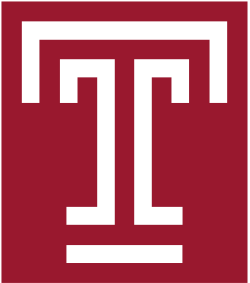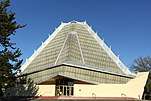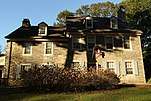Tyler School of Art
| Type | Art school |
|---|---|
| Established |
1935 (as Stella Elkins Tyler School of Art) |
| Students | 1,550 |
| Location | Philadelphia, Pennsylvania, United States |
| Campus | Urban |
| Website | https://tyler.temple.edu |
The Tyler School of Art is an art and architecture school based at Temple University, a large, urban, public research university in Philadelphia, Pennsylvania.[1] Tyler currently enrolls about 1,350 undergraduate students and about 200 graduate students in a wide variety of academic degree programs, including architecture; art education; art history; art therapy; ceramics; city and regional planning; community arts practices; community development; facilities management; fibers and material studies; glass; graphic and interactive design; historical preservation; horticulture; landscape architecture; metals/jewelry/CAD-CAM; painting; photography; sculpture; and visual studies.[2] Tyler's art programs "have long been considered among the finest in the nation."[3] The school is currently ranked tied for No. 15 in the nation among fine arts schools in U.S. News' Best Graduate Schools rankings, and three of Tyler's individual MFA programs are ranked in the top 10.[4]
Founded in 1935 by Stella Elkins Tyler and sculptor Boris Blai in nearby Elkins Park, Pennsylvania[5], Tyler moved to a new, 255,000-square-foot facility at Temple's Main Campus in 2009 with the cornerstone financial support of an allocation of $61.5 million from the Commonwealth of Pennsylvania[6][7] In 2012, Tyler's Department of Architecture moved into a new facility connected to the main Tyler building.[8] Temple’s departments of Landscape Architecture & Horticulture (based primarily at Temple's suburban Ambler Campus) and Planning & Community Development joined Tyler in 2016, unifying all of the university's built-environment design disciplines in one school for the first time.[5]
In 2017, arts administrator, art historian and curator Susan E. Cahan, formerly associate dean and dean for the arts at Yale College at Yale University, was appointed dean of the Tyler School of Art by Temple President Richard M. Englert.[9]
Programs[2]
The Tyler School of Art offers a wide range of degree and certificate programs in the areas of art, built-environment design, graphic design, art history and art education. Tyler students also have access to the comprehensive programs and resources of Temple University.
Under Susan E. Cahan, Tyler's dean since 2017, Tyler has placed a renewed emphasis on cross-disciplinary studies and collaboration in its academic and co-curricular programs.[10]
- Architecture (BSArch, MArch, MSArch**)
- Art (BA, available only at Temple University, Japan Campus)
- Art Education (BFA with art education concentration, BSEd, MEd with major in art education)
- Art History (BA, MA, MA with fine arts administration track, PhD)
- Art Therapy (BA)
- Business of Architecture (certificate)
- Ceramics (BFA*, MFA)
- City & Regional Planning (MS)
- Community Arts Practices (certificate)
- Community Development (BS)
- Creative Entrepreneurship (certificate)
- Facilities Management (BS, MS
- Facilities Planning (BS, MS***)
- Fibers & Material Studies (BFA*, MFA)
- Foundations (non-degree granting program for freshmen)
- Glass (BFA*, MFA)
- Graphic & Interactive Design (BFA*, MFA)
- Historic Preservation (BS)
- Horticulture (BSHort, ASHort)
- Landscape Architecture (BSLArch, MLArch)
- Metals/Jewelry/CAD-CAM (BFA*, MFA)
- Painting (BFA*, MFA)
- Photography (BFA*, MFA)
- Printmaking (BFA*, MFA)
- Sculpture (BFA*, MFA)
- Visual Studies (BA)
* also available as BFA with Entrepreneurial Studies or a BFA with Art Education concentration
** post-professional degree available with optional concentrations in Advanced Technologies and Design, Urban Ecologies and Design, Health and Design.
*** post-professional degree available with an optional concentration in Health and Design.
Facilities
Since 2009, when the Tyler School of Art moved into its new home, a 250,000-square-foot building designed by award-winning architect Carlos Jiménez[7][11], Tyler's art students and faculty have had access to expansive, state-of-the-art facilities. Tyler's architecture students and faculty experienced a similar boost in size and quality of facilities when the program moved into a new, 50,000-square-foot Architecture Building in 2012—Temple's first building dedicated solely to architecture.[8] The two structures, which are connected by a glass-enclosed passageway, are located at Temple University's Main Campus in Philadelphia, giving the Tyler community access to the city's museums, galleries and other arts-related resources. Their location adjacent to Presser Hall (part of Temple University's Boyer College of Music and Dance) and Temple Theaters (part of Temple's School of Theater, Film and Media Arts) has created an arts quadrant in the northeast corner of campus.[7]
Notable discipline-specific facilities at Tyler include:
Tyler's facilities include:
- The Architecture Building, with four floors of studios and exposed air ducts, plumbing pipes and lights in order for students to observe the building’s infrastructure.[12]
- A 10,000-square foot ceramics facility—one of the largest in the nation—with four gas kilns, 13 electric kilns, a large glaze room and more.[12]
- Fibers and material studies studios equipped with a computer lab for silk screening and digital printing, a computerized loom and a large-format printer.[12]
- A glass facility with a hot shop with two 530-pound day tanks, four benches and four glory holes; and a cold shop with Merker and Czech lathes and four flameworking stations.[12]
- Landscape architecture and horticulture facilities at Temple University’s large, suburban Ambler campus that include a 187-acre Ambler Arboretum and a 5,600 square foot greenhouse.[13]
- A 5,600-square-foot metals/jewelry/CAD-CAM facility with 56 bench-top torches, three burn-out ovens, a computer lab, a crucible, a centrifuge, two 3-D printers and more.[12]
- Painting and drawing rooms, each more than 1,000 square feet with a north-facing wall of windows, providing ideal light and views of Philadelphia.[12]
- A 9,000-square foot photography facility with two large wet labs, a lighting studio, a critique room, an exhibition gallery, computer studios with large-format printing and more.[12]
- Printmaking’s fully-equipped, 10,000-square-foot facility features three large rooms for lithography, etching/relief/monoprinting and screen printing.[12]
- Sculpture’s 16,000-square-foot space includes a complete woodshop and metal fabrication shop, two-ton gantry cranes, hoists, an outdoor assembly area and a 1000-square-foot outdoor pad.[12]
- Digital services facilities that include a Digital Fabrications Studio where students have access to 3D printers, 3D scanning, vinyl cutting, laser cutting and a ten-needle embroidery machine; a Media Output Center with archival-quality printing up to 64 inches wide; and a Visual Resource Center with a wide variety of scanners, projectors, DSLR cameras and more.[14]
- The central courtyard between Tyler's two primary buildings is one of the largest green spaces at Temple University's Main Campus. In 2018, the Nicholas Kripal Natural Dye Garden, a collaboration between students and faculty in Tyler's Fibers & Materials Studies and Landscape Architecture programs, was installed in the courtyard, part of a plan to re-activate the courtyard and make it a space for interdisciplinary collaboration and recreation.[15]
Rankings[4]
U.S. News and World Report's annual Best Graduate Schools rankings list the Tyler School of Art as No. 15 Fine Arts school in the nation (tied with four other institutions). Tyler, which is listed as Temple University in U.S. News' Fine Arts rankings, is tied for No. 5 among the nation's public art schools, and is the only art school in the Philadelphia region to be ranked in the top 30. Several of Tyler's individual MFA programs also earn national top-10 ranks from U.S. News, including glass (ranked No. 2 in Best Graduate Schools), printmaking (no. 7) and painting/drawing (no. 10).
History[5]
Stella Elkins Tyler (of the Elkins/Widener family) donated her estate in Elkins Park, Pennsylvania, to Temple University in the early 1930s. With an interest in progressive education and a deep appreciation of her mentor, the sculptor Boris Blai, Tyler offered her estate with the expressed wish that, through Boris Blai, it would become an environment for the advancement of the fine arts, scholarly study in the arts and individual creativity.
As founding dean of the Tyler School of Art, Blai instilled the school with a commitment to progressive education emphasizing the student's mastery of technique within the framework of a liberal arts curriculum. Blai insisted upon individual attention to each student's needs as the basis of successful teaching. During his 25-year tenure as dean, Blai shaped the school into one of the finest visual arts centers in the country, and his founding ideals still remain paramount to Tyler's educational philosophy.
In 1960, Charles Le Clair succeeded Blai. Under Le Clair, the Tyler campus was improved with construction of a residence hall and two studio/classroom buildings. In 1966, Le Clair founded the Tyler Study Abroad program in Rome, Italy. Tyler's programs at Temple University Rome remain among the most respected fine arts study abroad programs in Europe today. Temple University Rome has expanded to include a full range of liberal arts, architecture, business and law courses with an emphasis on those relating to Rome, Italy and Europe.
Throughout the 1960s and 1970s, Tyler's curriculum continued to grow in response to new definitions of art-making and the role of art in society. New programs and modern facilities in design, ceramics, glass, metals and photography were added. During this time, Tyler developed Art Education and Art History departments on Temple's Main Campus in Philadelphia.
The pace of change and growth began to accelerate dramatically in the late 1990s. In 1998, Tyler welcomed Temple’s Department of Architecture. In 2009, Tyler moved from Elkins Park into a new, 250,000-square-foot building at Temple’s Main Campus. Three years later, Architecture moved into a new 50,000-square-foot facility connected to the new Tyler building. In 2016, Temple’s departments of Landscape Architecture & Horticulture and Planning & Community Development became part of Tyler, for the first time unifying all of the built-environment disciplines at Temple in one academic unit. Then, in 2017, the Tyler School of Art welcomed Susan E. Cahan, who came from Yale University to become Tyler’s first permanent dean since the school moved into its new building in 2009.
In 2018, Temple University's Board of Trustees approved approved changes that will streamline and update the Tyler School of Art’s structure and expand the school’s name, effective with the 2019-20 academic year. The changes, which will take effect in July 2019, include the realignment of Tyler’s arts programs to support cross-disciplinary studies and reflect current understanding of creative practice and research, and the expansion the school's name to the Tyler School of Art and Architecture.[16]
Notable alumni
- Dennis Adams, artist
- Polly Apfelbaum, artist
- Larry Becker, gallerist
- Bill Beckley, narrative/conceptual artist
- Moe Brooker, artist
- Harriete Estel Berman, artist
- Karen Boccalero, artist, nun, founder of Self-Help Graphics in Los Angeles
- Regis Brodie, artist and professor of ceramics at Skidmore College
- Barbara Chase-Riboud, visual artist, novelist and poet
- Chuck Connelly, painter
- Alix Dobkin, singer-songwriter
- Trenton Doyle Hancock, artist
- Angela Dufresne, painter
- Louise Fishman, abstract painter
- Nick Fudge, artist
- Doreen Garner, artist
- Frank Gaylord, sculptor
- Robert Gober, sculptor
- Edgar Heap of Birds, artist
- Tim Heidecker, actor and comedian
- Jessica Hische, illustrator
- Irvin Kershner, film director
- Simmie Knox, portrait painter
- E. B. Lewis, illustrator
- Deborah Margo, artist
- Ree Morton, artist
- Nicholas Muellner, photographer and writer
- Albert Paley, artist
- Laura Parnes, artist
- Marlo Pascual, artist
- Janet Perr, designer, Grammy Award-winning art director, illustrator and author
- Amy Pleasant, painter
- Erin M. Riley, artist
- Paula Scher, designer
- Susan Sensemann, American artist
- Sarai Sherman, painter
- Aaron Shikler, portrait painter
- Lisa Sigal, artist
- Laurie Simmons, photographer
- John Stango, artist
- Richard Sylbert, two-time Academy Award-winning production designer
- Diana Vincent, jewelry designer
- Eric Wareheim, actor and comedian
- Aaron Wexler, artist
- Hannah Wilke, sculptor and photographer
- Lisa Yuskavage, painter
- Paul O. Zelinsky, author and illustrator of children's books
- Tamsen Wojtanowski, artist
Notable current and past faculty
- Boris Blai, sculptor
- John E. Dowell Jr., printmaker
- Mark Thomas Gibson, artist
- C.T. Jasper, artist
- Stanley Lechtzin, jewelry and metals artist
- Roberto Lugo, ceramic artist
- Dona Nelson, painter
- Odili Donald Odita, painter
- Pepón Osorio, artist
- Rudolf Staffel, ceramic artist
References
- ↑ "Schools and Colleges | Temple University". www.temple.edu. Retrieved 2018-10-14.
- 1 2 "Academic Programs". Tyler School of Art. Retrieved 2018-10-14.
- ↑ Hilty, James (2010). Temple University: 125 Years of Service to Philadelphia, the Nation, and the World. Temple University Press. p. 227. ISBN 1439900191.
- 1 2 "U.S. News Best Fine Arts Programs". U.S. News & World Report. October 14, 2018.
- 1 2 3 "Mission, Vision and Values". Tyler School of Art. Retrieved 2018-10-14.
- ↑ Boccella, Kathy. "Big move ahead for Tyler School of Art Art school prepares for a larger canvas". Philly.com. Philadelphia Media Network (Digital) LLC. Retrieved 16 November 2014.
- 1 2 3 "Tyler move creates Temple arts hot spot". Temple Now | news.temple.edu. 2009-02-05. Retrieved 2018-10-14.
- 1 2 "Architecture moves into dedicated building". Temple Now | news.temple.edu. 2012-01-26. Retrieved 2018-10-14.
- ↑ "Susan E. Cahan appointed dean of Tyler School of Art". Temple Now | news.temple.edu. Retrieved 2018-10-14.
- ↑ "Meet Tyler dean Susan Cahan". Tyler School of Art. Retrieved 2018-10-14.
- ↑ "Tyler School of Art (2005-2009)". Carlos Jiménez Studio. Retrieved 2018-10-14.
- 1 2 3 4 5 6 7 8 9 "Explore Our Facilities | Tyler School of Art". tyler.temple.edu. Retrieved 2018-10-15.
- ↑ "Gardens | Ambler Campus". ambler.temple.edu. Retrieved 2018-10-15.
- ↑ "Tyler Digital Services". Tyler School of Art. Retrieved 2018-10-15.
- ↑ "Tyler School of Art on Twitter". Twitter. Retrieved 2018-10-15.
- ↑ "Trustees approve Tyler changes". Tyler School of Art. Retrieved 2018-10-15.
External links
Coordinates: 39°58′59″N 75°09′13″W / 39.983162°N 75.153556°W


